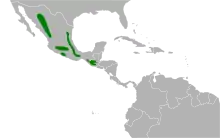| Hesperiphona | |
|---|---|
 | |
| Male evening grosbeak | |
| Scientific classification | |
| Domain: | Eukaryota |
| Kingdom: | Animalia |
| Phylum: | Chordata |
| Class: | Aves |
| Order: | Passeriformes |
| Family: | Fringillidae |
| Subfamily: | Carduelinae |
| Genus: | Hesperiphona Bonaparte, 1850 |
| Type species | |
| Fringilla vespertina Cooper, W, 1825 | |
Hesperiphona is a genus in the finch family Fringillidae.
The genus was introduced in 1850 by the French naturalist Charles Lucien Bonaparte with the evening grosbeak as the type species.[1] The name combines the Ancient Greek hesperos meaning "evening" and phōnē meaning "sound" or "cry".[2]
Species
The genus contains two species:[3]
| Common name | Scientific name and subspecies | Range | Size and ecology | IUCN status and estimated population |
|---|---|---|---|---|
| Evening grosbeak
|
Hesperiphona vespertina (W. Cooper, 1825) |
Canada and the western mountainous areas of the United States and Mexico |
Size: Habitat: Diet: |
LC
|
| Hooded grosbeak
|
Hesperiphona abeillei (Lesson, R, 1839) |
Central America, principally in Mexico and Guatemala. |
Size: Habitat: Diet: |
LC
|
References
- ↑ Bonaparte, Charles Lucien (1850). "Sur plusieurs genres nouveaux de Passereaux". Comptes Rendus Hebdomadaires des Séances de l'Académie des Sciences (in French). 31: 423–424 [424].
- ↑ Jobling, James A. (2010). The Helm Dictionary of Scientific Bird Names. London, United Kingdom: Christopher Helm. p. 190. ISBN 978-1-4081-2501-4.
- ↑ Gill, Frank; Donsker, David; Rasmussen, Pamela, eds. (2020). "Finches, euphonias". IOC World Bird List Version 10.2. International Ornithologists' Union. Retrieved 13 January 2021.
This article is issued from Wikipedia. The text is licensed under Creative Commons - Attribution - Sharealike. Additional terms may apply for the media files.

